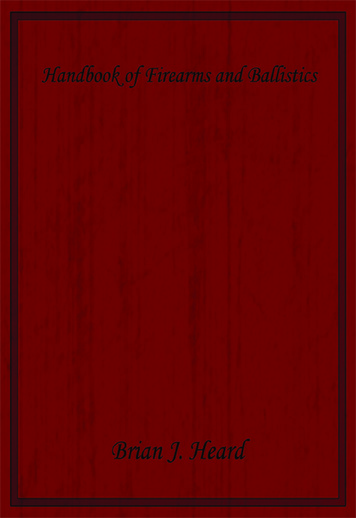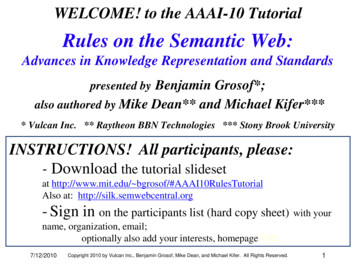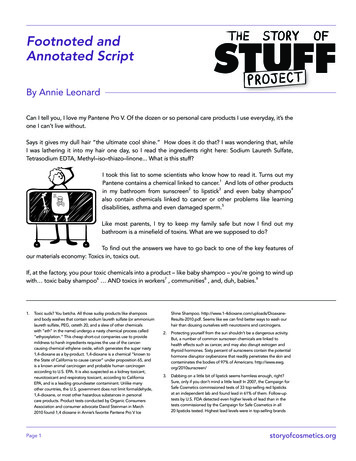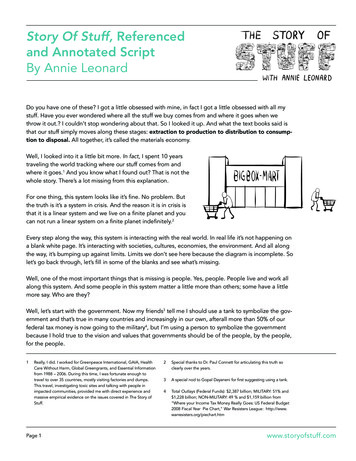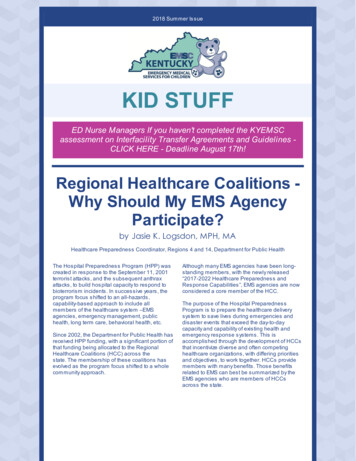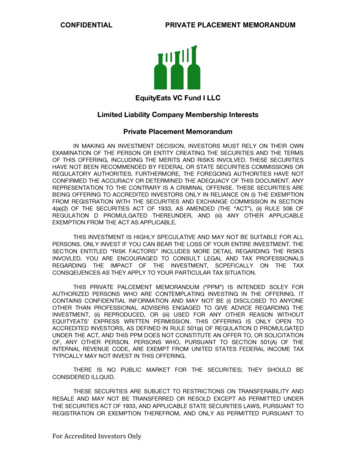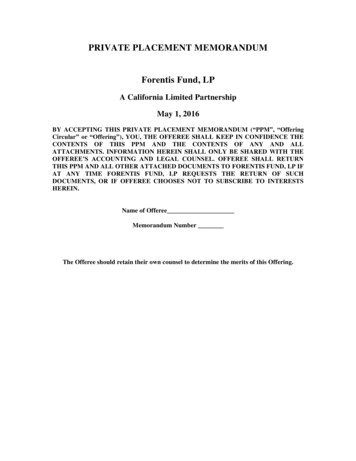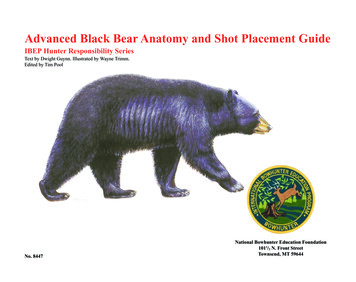
Transcription
Advanced Black Bear Anatomy and Shot Placement GuideIBEP Hunter Responsibility SeriesText by Dwight Guynn. Illustrated by Wayne Trimm.Edited by Tim PoolNo. 8447National Bowhunter Education Foundation1011/2 N. Front StreetTownsend, MT 59644
Black Bear Shot PlacementWhere to Aim - BroadsideFirearm hunters and bowhunters have a responsibility to make quick kills and recoverall game. One complaint that members of the public (other hunters and nonhunters) have about hunters is “slow deaths, wounded and unrecovered animals.”Accurate shot placement is the key to a quick kill and game recovery. Necessaryingredients of good shot placement are knowledge of how a hunting arm harvests game,shooting only within one’s ability, and knowing the game animal’s internal anatomy. Thefuture of hunting and a hunter’s self-respect depend on their ability to efficiently harvestgame.Bow: A bear standing broadside represents the best bow shot because it requires the least amount ofpenetration to reach the vital organs. In addition, the broadside shot is also the best angle for the arrow topenetrate both lungs. A bear’s long hair and compact body may cause a hunter to shoot further back on abear’s body, possibly causing a poor hit in the paunch area. Find the best aiming spot on a bear byfollowing a line up the center of the nearside front leg to a point 1/3 to 1/2 up the chest. A bear’s shoulderis farther forward than that of other deer-like animals, and the shoulder bones form a tighter angle. Thus,the aiming point is slightly farther back from the shoulder than of a deer. The front leg offers a perfectsite-line to the chest area. If the legs are spread, wait for the nearside leg to move forward. This will openup the chest area. Pick a spot up the between the two front legs to a point 1/3 to 1/2 up the chest. Bothmethods will guide you to put the arrow in the center of the vital area by enabling you to pick a spot ratherthan shooting at the whole animal. Remember - an arrow will penetrate through the ribs, but be careful toavoid the shoulder bone. Wait until the near front leg is forward and concentrate on a spot behind theshoulder. Never consider head and neck shots. The brain and spine are small targets protected by heavybone. The only artery of any size in the neck is the carotid, which is only the size of a pencil. Wait for thechest shot behind the shoulder!Shot placement is especially important for black bear hunters due to the potentially large size of bears (upto 600 pounds) and the fact that bears may attack a hunter if wounded. Bears are significantly different instructure than that of other animals. Also, bears have heavier bones and hides than other big game animals.The long fur and layers of fat found on bears often inhibits blood from dripping onto the ground, makingtrailing more difficult. The only responsible conclusion is good shot placement for a quick kill.How an Arrow WorksArrows tipped with razor sharp broadheads are designed to cut. Arrows harvest gameby cutting arteries and veins resulting in blood loss. In addition to severe bleeding,arrows shot through both lungs cause the lungs to collapse, resulting in rapid deaththrough suffocation. Arrows can cut through softer bones like ribs, but arrows shot fromeven a very heavy bow will rarely penetrate the heavy bones found in the shoulder, hips, head andneck. Thus, both razor sharp broadheads and careful shot placement are crucial to game recovery.Gun: The broadside position offers several excellent shots for a firearm hunter. The best target is theshoulder and chest area. A bullet of the correct weight, design and fired from an adequate firearm willbreak the shoulder and enter the heart or lungs. A neck shot will drop an animal instantly. However, theneck of a bear appears relatively short (especially on large bears). Also, the skull of bear is constructed ofheavy bone and is sloped at sharp angles. This makes correct bullet placement for penetration of the skulldifficult. Therefore, head and neck shots should be used only if you are proficient with your firearm anduse of a proper firearm and bullet.How a Bullet WorksWhere to Aim - Quartering AwayBullets harvest game by massive shock and tissue destruction. A small bullet travels at very high speed(energy) and transfers that energy to the animal upon impact. The bullet is effective in killing the animal ifit is of the proper design and fired from a firearm adequate for the game being hunted. A bullet can evensmash through heavy bone and enter into the vital organs.Bow: A quartering away animal offers a good bow shot on deer-sized animals, but is less desirable forlarger big game animals. It helps one avoid the heavy bones of the shoulder area in bears, but the size ofthe bear, the weight of the bow and ability to gain arrow penetration through the intestines and stomachinto the vital organs of the chest must be considered. When picking a spot on a quartering away animal,think 3-D dimensionally. Imagine where the lungs are and determine where to aim so that the arrow willmiss heavy bones and angle forward into the vital area. The exact aiming spot will vary with the degree towhich the animal is quartering away. Remember that this angle is very important. The more the animalangles away, the closer you are to making a wounding rear-end shot. The less the animal angles away, thecloser you are to having a broadside shot and the better the opportunity of penetrating both lungs. Usingthe far side front leg as a guide may help you pick the aiming spot. Imagine the arrow needing to hitthe far side front leg, find the aiming point on the near side that will allow the arrow to follow thispath.Hunting bear with muzzleloading rifles presents special shot placement considerations. The relativelyheavy projectile shot from a muzzleloader travels at slower speeds and has less energy than those frommost centerfire rifles. At the same time, loading from the muzzle means that more than one shot at a bearis unlikely. Thus, muzzleloader hunters should limit their shots at bear to within their personal effectiverange, not to exceed 100 yards.Internal Anatomy of BearStudy the bear diagram. A spot in the center of the lungs or slightly lower should be a bowhunter’starget every time. An arrow or bullet in both lungs will bring down the largest game, and theadvantage of this shot is that the lungs are relatively large and surrounded by other vital organs: theheart is between the lungs, the aorta artery is at the top of the heart, and the liver and kidneys are tothe back of the lungs, and the spine runs along and just below the top of the back. While bowhuntersshould avoid the large bones of the shoulder and spine area, an arrow tipped with a sharp broadheadcan penetrate the softer rib bones making the lung area the best target. Hunters using firearms havemore choices. A bullet striking the heart, lungs, shoulder, or spine is fatal to a bear due to themassive shock and tissue destruction. Once again, the chest area offers the best lethal target forfirearm hunters.Gun: The quarteringaway position offersseveral lethal targets forfirearms. Furtherbehind the shoulder isthe best aiming spot.Avoid a shot that willhit the paunch area.2
THE BEAR3
Muscles4
Skeleton5
Circulatory System6
Organs7
8
SHOT PLACEMENTMaking clean, certain kills should be the top priority once a hunter decides to shoot an animal. Consistent one-shot kills require marksmanship skillsand knowledge of bear anatomy, and a true-shooting firearm or bow. A hunter shooting within their personal effective range will also improve theprobability that the projectile will hit the aiming spot. An animal taken cleanly and humanely shows more character of the hunter than a lucky longshot.The best shot for archers and firearm hunters is one that has the bear broadside where the arrow or bullet has the least amount of distance to enter intothe chest cavity. This shot leaves the most room for error. The quartering away shot also offers a target, but the projectile may be slowed because ofthe intestinal tract.Whatever the hunting tool, bear shot through the heart or lungs drop fairly quickly. The results are a well-bled carcass and minimal amount ofdamaged meat.Gun or BowWait for the near front leg to move forward.MAKING CLEAN, CERTAIN KILLS SHOULD BE THETOP PRIORITY ONCE A HUNTER DECIDES TOSHOOT A BEAR. THE BEST SHOT FOR ARCHERSAND FIREARM HUNTERS IS ONE THAT HAS THEBEAR BROADSIDE WHERE THE ARROW OR BULLET HAS THE LEAST AMOUNT OF DISTANCE TOENTER INTO THE CHEST CAVITY. AN ANIMALTAKEN CLEANLY AND HUMANELY SHOWS MORECHARACTER OF THE HUNTER THAN A LUCKYLONG SHOT.9
Where to Aim - Quartering TowardWhere to Aim - Elevated StandsBow: This is one of the poorest bow shots and should not be taken. Picking aspot behind the shoulder will result in the arrow missing most of thevital organs and angling back into the stomach and intestines. Fromthis angle, heavy shoulder bones shield the majority of the vitalorgans from penetration by an arrow. An error of only an inch or twowill result in a miss or non-fatal hit in the shoulder. Another disadvantage of this angle is the possibility that the animal will see the hunterdrawing their bow. Wait for the broadside or quartering-away shot.Many bear hunters use elevated stands, mountainous terrain also present similar shot angles. The change inshot angle makes little difference to a hunter using a firearm, but results in a smaller portion of the vitalarea being exposed to a bowhunter. The position of bones in relation to the vital organs changes more andmore as the angle increases. The backbone and shoulder blade shield more and more of the chest cavity asthe angle gets steeper. This decreases the available vital organ area for good shot placement. Completepenetration will result in a good blood trail; avoid the bones that could prevent the arrow from exiting lowin the animal. Elevated stands also make it more difficult to hit both lungs with your arrow. Consider theangle of the shot when deciding how high your stand should be. (See the NBEF Tree Stand Guide).Bowhunters should be sure to practice from elevated stands before hunting. Shooting down at narrowertargets is very different than shooting horizontally at targets on the ground. From the point you touch thetree to leaving the tree, always wear a fall restraint harness when practicing and hunting from elevatedstands so that you can concentrate on making a good shot without the fear of falling.Gun: The quartering-toward angle is fine for centerfire rifles, but is notrecommended for muzzleloading rifles. Aim at the neck or front of the shoulder foran effective hit. A light bullet may deflect off the shoulder bone of bear. Be certain you use a firearm andammunition adequate for the game hunted and the type of shot you select.Where to Aim - Head-On ShotsBow: This is a very poor shot for a bowhunter. The vital organ area is at the base of the neck (throat)between the shoulders, which is an extremely small target. The animal must have its head up to exposethis small target area, and it will almost surely see the archer draw the bow. An alert bear is capable of“jumping the string” avoiding the arrow, or wounding the animal. Don’t take this shot.Gun: This is an acceptable shot with an adequate centerfire rifle. The neck and center of the chest arevital areas that the hunter can use as aiming points. However, a muzzleloader hunter should pass on thisshot angle because of the possibility of bullet deflection.Where to Aim - Rear-end ShotsBow: This is a shot all responsible bowhunters will pass up. The only major target in the rear quarters isthe femoral artery, which is smaller than your little finger and extremely well protected by heavy leg andpelvis bones. Also, the hindquarters have very dense muscle tissue, combined with the heavy bonestructure and viscera making it a long and questionable journey for an arrow to travel up to the vital organsof the chest.Gun: The rear-end shot is a poor shot with a firearm. A shot to the body at this angle may not bring downa bear quickly and could ruin the best cuts of meat. A neck shot is possible if the animal has its head up.Waiting for a better shot opportunity is recommended.10
Together Everyone Achieves MoreREMEMBER!Broadside standing bear offer the best shot for both firearm and bowhunters. Quartering away shots offer another good shot for firearm hunters, but is lessdesirable for bowhunters. The quartering away shot should also be avoided for larger big game animals like elk and moose. Smaller deer-sized animalsoffer an excellent quartering away target.REMEMBER!Firearm hunters are able to shoot from longer distances and have more target opportunities than those of a bowhunter. Quartering towards or facing headon may be acceptable for firearm hunters, but not bowhunters. Rear-end shots should be avoided by all hunters.REMEMBER!Correct shot placement not only depends on a hunter’s knowledge of game anatomy, but also on their ability to place the projectile in the vital area. Practice with your equipment on a regular schedule and know the distance at which you can put an arrow or bullet in the vital area every time. Practice underhunting conditions. Use full-sized animals where possible. Do not place any spot on the animal target. Make yourself pick the spot in the vital area eachtime you shoot. Shoot in the wind, rain, cold and hot, uphill and downhill, with your hunting clothes on, and at unknown distances. Firearm huntersshould practice with and without a rest and from a sitting kneeling, prone, and standing positions. Know the distance from which you can shoot accurately, and don’t shoot at an animal unless you know you can make a perfect shot.REMEMBER!Above all, respect the animal you are pursuing, other hunters, people who do not hunt, the environment and yourself. If you have respect andvalue the hunting experience, it will be reflected in your e
Firearm hunters and bowhunters have a responsibility to make quick kills and recover all game. One complaint that members of the public (other hunters and non-hunters) have about hunters is “slow deaths, wounded and unrecovered animals.” Accurate shot placement is the key to a quick kill and game recovery. Necessary ingredients of good shot placement are knowledge of how a hunting arm .


